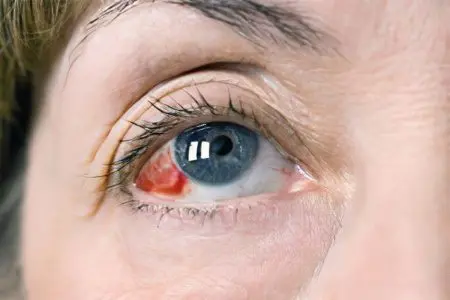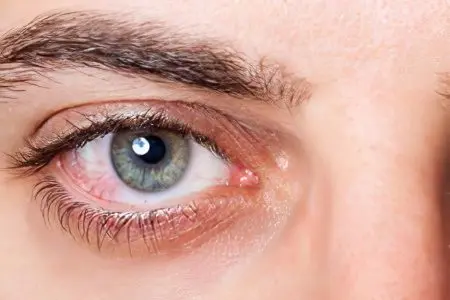Contents
The white of the eye, which has suddenly become red, or subconjunctival hemorrhage is a consequence of bursting blood vessels. In some cases, it does not completely change the shade, only spots of a characteristic color appear on the surface. The eye looks unnatural because of this, but its appearance, as a rule, is not the biggest problem in this situation.
Dangerous reasons that lead to the fact that the vessels burst. After all, such a phenomenon may be a consequence of the development of a serious disease and other disorders in the functioning of organs and their systems.
Why do blood vessels burst in the eyes?

The causes of hemorrhages, as a result of which the white of the eye turns red, may be the following:
Change in blood pressure. As a result of its sharp increase, the vessels fill with blood and burst. Often this phenomenon is encountered by patients with hypertension, which leads to a hypertensive crisis and affects important organs in the body: the brain, retina, kidneys. They are called targets because they are the first to be threatened during blood pressure surges. A hypertensive crisis always begins unexpectedly. Soon there is a sharp increase in pressure, which is accompanied by reddening of the eyes due to bursting blood vessels. The relief of a hypertensive crisis should be immediate. After all, a sharp increase in blood pressure increases the risk of complications, for example, myocardial infarction, aortic dissection, stroke. Even if the patient does not suffer from hypertension, he may have a hypertensive crisis due to alcohol consumption or a stressful situation.
Mechanical damage and eye injuries. Blows, bruises – all this can lead to bursting of blood vessels. Often subconjunctival hemorrhage occurs after eye surgery. This phenomenon is not dangerous, because the blood accumulates under the conjunctiva, resembling a bruise or hematoma.
Physical stress. An increased load, requiring concentration of forces, also provokes rupture of blood vessels. This problem arises as a result of serious training, at the time of lifting weights. In women, ruptures of blood vessels in the eyes are observed during contractions.
Diabetes. This disease causes microangiopathy, in which the capillaries are affected. An increase in blood glucose has a negative effect on the elasticity and strength of blood vessels, a destructive effect on blood vessels, as a result of which their walls thicken in places or, on the contrary, become thinner. Difficulty in blood flow and metabolism eventually leads to ruptures.
Eye strain. Prolonged work at the computer, watching TV, reading or writing in bad light create an increased load on the eyes, and the capillaries burst.
Increased weather sensitivity. Redness of the eyes can be a reaction of the body to a sharp change in weather conditions or climate. Changes in atmospheric pressure, temperature – all this leads to the fact that the sclera in some patients acquire a scarlet hue.
Keratitis. Eye redness, photophobia, tearing and corneal clouding are the main symptoms of this disease. Keratitis can be caused by a foreign body in the eye, a virus or fungus, a thermal burn, or an allergy. In this case, it is possible to cope with the rupture of capillaries by eliminating the disease. Its therapy depends on the causes of occurrence, with the determination of which treatment begins. With infectious keratitis, it is necessary to use antifungal, antiviral drugs. Antibacterial drops and ointments are prescribed for the bacterial nature of the disease. It is important to start treatment in time to avoid damage to the cornea.
Conjunctivitis. This inflammation affects the thin transparent film of the eye – the conjunctiva. It often occurs, like keratitis, due to allergies, beriberi, ingestion of infectious agents: staphylococcus, gonococcus, streptococcus, under the influence of irritants, such as smoke, dust. With conjunctivitis, blood vessels expand and burst, redness is observed, itching, burning. The disease can have a viral, bacterial and allergic form. It is transmitted by airborne droplets. Treatment of conjunctivitis is due to the causes of the disease. With their elimination, the redness of the eyes also disappears.
Tumors. Benign or malignant formations in the eyes lead to the fact that the vessels are deformed and ruptured.
Avitaminosis. The lack of ascorbic acid and vitamin P-rutin also makes the capillaries vulnerable. The lack of these elements contributes to capillary rupture. You can compensate for the lack of ascorbic acid by including citrus fruits, Brussels sprouts, peaches, persimmons, apricots in the diet. Rutin is also found in fruits, such as lemons, oranges, cherries, apples and many vegetables: beets, tomatoes, cabbage.
Fragile vessel walls. Capillaries become thinner after taking certain drugs or as a result of previous diseases. This problem is caused by glaucoma.
Head injury. In some cases, it causes a violation of the process of blood flow to the brain. In addition to bursting capillaries, migraines, nausea, insomnia, and fatigue often occur after a head injury. Magnetic resonance imaging helps to identify whether the problem of redness of the eyes is related to it.
A visit to the baths and saunas.
Dilated red blood vessels in the eyes

Microangiopathy – damage to small capillaries in the body. It becomes clearly visible in the redness of the eyes. Microangiopathy is a consequence of diabetes mellitus and affects all capillaries in the body. For example, in the lower extremities, it manifests itself in the form of gangrene, provokes kidney failure and negatively affects the eyes, leading to loss of vision.
In medicine, damage to the capillaries in the eyes is called diabetic retinopathy. Ruptures of pathologically altered vessels that have become fragile, a gradual decrease in visual acuity indicate this disease. Redness of proteins can be triggered by increased physical exertion (sudden movements, head tilt) or occur for no apparent reason. If this problem occurs, patients with diabetes should contact an endocrinologist who will help prescribe or adjust hypoglycemic therapy.
Unless the broken capillaries are associated with a serious medical condition, they should not be a cause for concern. They are usually caused by eye strain. It occurs when doing small work that requires concentration of attention: reading or writing, needlework. Eye capillaries are thin and fragile structures, the main purpose of which is to maintain the life of the eye. Prolonged load of the visual analyzer leads to spasm of the visual muscles, spasm of accommodation, dysregulation of vascular tone. As a result of these processes, the capillaries are filled with blood, their walls are torn, and hemorrhage occurs.
How to remove red blood vessels in the eyes?
Eliminating the causes that caused this phenomenon helps to cope with dilated red capillaries. Depending on this, the appropriate treatment is selected.
If capillary ruptures are caused by lack of sleep, alcohol abuse, fatigue or physical exertion, it is necessary to let the body rest and recover, give up alcohol, try to observe the daily routine and eat right.
To reduce the load on the visual analyzer allows you to perform special exercises for the eyes. The elimination of the etiological factor usually allows you to get rid of the redness of the proteins. But if such measures are ineffective, you should consult an ophthalmologist.
How to treat blood vessels in the eyes?
Attacks of certain diseases, during which the vessels in the eyes burst, require emergency care. With glaucoma, 1% pilocarpine is instilled every quarter of an hour. Severe pain in the eyes with this disease helps to relieve analgesics administered parenterally. These measures allow lowering intraocular pressure, which means normalizing blood circulation and preventing capillary ruptures.
In case of an attack of hypertension, you should chew 2 aspirin tablets to prevent a heart attack, and then consult a doctor. After all, vascular ruptures in this case are a symptom that can be eliminated by stopping the hypertensive crisis.
Capillaries burst due to an overdose of coagulants. Such blood thinning drugs are taken for various diseases: atrial fibrillation, coronary heart disease, thrombophilia. Among the side effects of their use are not only ruptures of small vessels in the eyes, but also uterine bleeding, hemorrhagic skin rashes, bleeding gums. In this case, it is also necessary to urgently seek medical advice. He will select the right drug and determine the dosage.
Drops if a vessel in the eye bursts
Visin:
Drops have a decongestant and vasoconstrictor effect. Their main advantage: they practically do not enter the systemic circulation, while they act very quickly. The effect of the drug lasts up to 8 hours. Vizin drops can be used if the redness of the whites of the eyes is caused by conjunctivitis, an allergic reaction. They are suitable for patients who wear contact lenses.
Vizin is instilled several times a day until all symptoms of inflammation are eliminated. It is not recommended to use the drug for longer than 4 days, as it can be addictive. Drops are contraindicated in patients with individual intolerance to the components that make up Vizin, as well as with increased intraocular pressure. After instillation, there may be a burning sensation, itching, tearing. Often blurred vision. If there is no improvement within two days, Vizin should be changed to other drops.
Tauphone:
This drug has a low cost, but is very effective in ruptures of blood vessels in conjunctivitis, dystrophy and damage to the cornea, cataracts. Normalization of blood circulation occurs due to the stimulation of metabolic and energy processes in the body. In addition, Taufon stabilizes cell membranes and intraocular pressure. The drug is used for diseases of the retina, dystrophy and damage to the cornea, cataracts.
Bury Taufon 1-2 drops several times a day. The duration of the course of treatment depends on the specific disease that caused capillary ruptures in the eyes. For cataracts, drops are used for several months. Taufon is contraindicated in case of individual intolerance to taurine, which is part of the drug, pregnant women and patients under the age of 18 years.
Emoxipine:
It helps to strengthen the vessels in the eyes, providing an angioprotective and antihypoxic effect. Emoxipin strengthens capillary walls, reduces their permeability and stimulates the circulation of intraocular fluid. After applying the drops, there is an improvement in blood rheological parameters, resorption of small intraocular hemorrhages. Emoxipin is indicated for use in diabetic retinopathy, corneal burns, myopia and glaucoma. Drops can also be used as a preventive measure to prevent ruptured capillaries in the eyes and improve blood circulation. Wearing contact lenses is not a contraindication for treatment with this drug.
Emoksipin is instilled during the day at least 2 times in the conjunctival sac. If the use of the drug causes severe discomfort, redness, itching and burning, increased pressure, you should stop using it. Before instillation, it is necessary to remove contact lenses and put them on half an hour after the procedure. It is not recommended to combine emoxipin with other drops.
Author of the article: Degtyareva Marina Vitalievna, ophthalmologist, ophthalmologist









